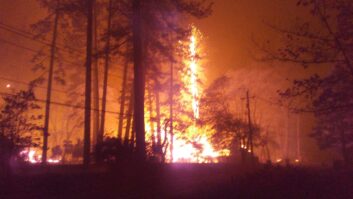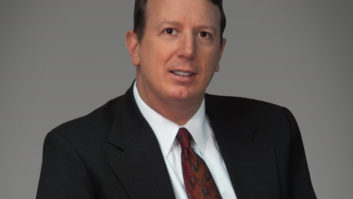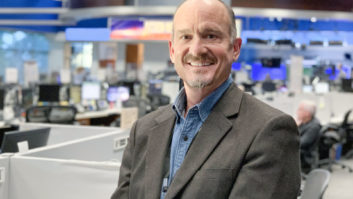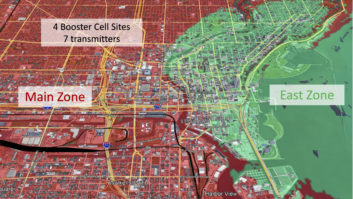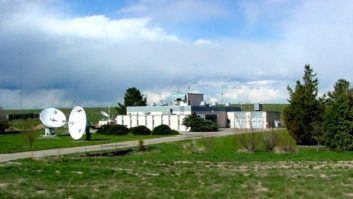Signals from the sky
Nov 1, 2000 12:00 PM, Conrad Trautmann
Many of us have experienced the effects of consolidation. Owners are squeezing as many stations as they can into as little space as possible. Six, seven, eight or even more stations are broadcasting from one building. But can you imagine running 100 stations from a single location?
That’s exactly what Siruis Satellite Radio is about to do. By the end of this year, Sirius will broadcast 100 different radio channels from its studios in the Rockefeller Center area of New York City. Audio and associated data will be broadcast, via satellite and approximately 100 terrestrial repeaters, to listeners in automobiles nationwide.
What does it take to create the programming for such a venture? We’ll look at the studios for both live and recorded programming, the equipment used to route audio within the facility and how it gets to your new satellite radio.
Open the door Let’s start with 100,000 square feet of floor space on the 36 superscript th and 37 superscript th floors of the McGraw-Hill building at 1221 Avenue of the Americas in Manhattan. Add the architectural design of NY’s own HLW architects. Stepping off the elevator and through the glass doors, you are amazed when you walk into the two-story reception area. A hardwood floor flanked by chrome and glass rooms on either side makes for an impressive greeting.
Looking to the right, you’ll see what looks like mission control at NASA (and isn’t far from it in its function). A three-seat console is clearly visible from the waiting area, and above it is a very large monitor that displays a signal from the computer console screen or any other video source that is selected. The room, officially named Telemetry, Tracking and Control (TT&C), has a direct link to the earth stations in Panama and Equador that control the satellites’ orbits. Although the three satellites that Sirius will use will be flown by Loral for their first year of service, the long-term goal will be to control everything from the TT&C room.
Across from TT&C, and similar in size, is a glass-enclosed room that serves as a performance studio. Equipped with sound treatment and professional television-style lighting, the room has a slightly live sound to it and is used primarily for acoustic performances. Another performance studio exists within the studio area for acoustic and electric performances.
The facility has a total of 22 physical studios that are all on a six-inch raised floor. Unlike traditional radio, Sirius radio’s 100 channels will be largely pre-produced. Voice tracking and pre-recording special programming for air at a later time will be the primary method of creating the individual channels. That said, any of the studios can be routed to any channel live, and the studios are equipped as any radio station air or production room would be. Wheatstone D-600 digital audio consoles are the centerpiece of each studio and are set into rounded-edge furniture built by Long Island’s Forecast Consoles. Add Panasonic SV-series DAT machines, Denon 961-FA CD players, Telos Systems telephone hybrids, 360 Systems Shortcuts, Genelec monitor speakers, and Eventide broadcast delays, and you have the equipment that many stations use in their own on-air and production environments. Interroom communication is handled by an RTS/Telex intercom system, audio editing is done with Avid’s Pro-tools system on WindowsNT. The Pro-tools workstations are networked to their own storage network for production element archiving.
Also used is a full range of microphones, including Electro-Voice RE20s in the air studios, Neuman U87s, AKG 414s and a wide range of specialty mics for drums. All the mics are processed with Symetrix 628s. Commscope 7538 is the cable used for all the digital audio routing.
There is also a Leitch 16 x 16 switcher that routes audio within a studio, which also solves an important problem: it converts the remaining analog signals in each room to digital. The entire facility is all-digital. This was a big step according to vice president of the National Broadcast Studio, Mark H. Kalman. Between the studios, audio is routed by an NVision NV 3512 512 x 512 AES audio router.
This router is integral to the Sirius facility in its ability to route AES-18 signals, which require more bandwidth than typical AES-3 signals. The AES-18 signals, created by a Quancom rack-mounted unit, carry both audio and RS-232-encoded data. This gives Sirius the ability to encode music and audio with data information that can be read by computers internally for control of equipment like the switchers and also streamed right out of the facility to the end user for an RDS-like readout on the receiver.
The router is wired with coaxial cable and is terminated with ADC coax patch panels. Very much like TV, these higher-bandwidth digital signals are all synchronized to a reference clock to prevent pops and clicks. Timing is critical within the facility and over the terrestrial repeater network. Everything is time-synchronized to rubidium-standard clocks linked to GPS. The router is fully redundant, like many of the other systems in the facility.
Audio storage and automation Another item that can’t be left out in the studio design is the Prophet Systems NexGen digital audio storage and automation system. Approximately 60 Prophet workstations are spread out among the facility in studios and offices. In the studios, wireless computer keyboards and mice are installed for a clean look and ease of use. Channel programmers have the ability to edit logs and listen to their channel’s audio right at their desks. Voice tracking is possible from anywhere in the world. The Prophet also integrates with the Pro-Tools system, using a drop-box style utility to save audio to the on-air delivery system.
The Prophet system includes fully redundant Hewlett-Packard RAID array hard drive systems. The RAID drives are hot-swappable, and the Prophet can automatically switch to the redundant system in the event of a failure with the first. Plus, each workstation has an 18GB hard drive, which stores approximately three days of audio on its own, in the event the entire RAID system fails. Running on a network backbone on Novell 5.0 and using WindowsNT as the workstation operating system, the Prophet uses 112 rack-mounted workstations in the equipment room to deliver audio to the multiplexer. Cybex Autoview commanders help save space by switching keyboard, mouse and monitor among all of the computers. The system was designed to automatically switch to the next available computer in the event of a failure. With 100 channels, that leaves 12 spares. 4.2TB (terabytes – that’s 4,200GB) of audio storage is available. All audio is recorded uncompressed (no data reduction). Considering that the transmission process will use Lucent’s PAC audio compression, the goal is to start off with absolutely the best quality to minimize transcoding losses.
The outputs of these machines are then run to their own dedicated Orban 6200 DAB digital audio processor. Each processor will be adjusted for the individual format. It was pointed out to me that the competition for dial loudness does not exist, but the listening environment and the wide dynamic range of some of the source material require some gain reduction and compression. To simplify adjusting 100 audio processors, the RS-232 port of each unit was brought out to a Chase IOLan rack-mount unit. The Chase gives each processor its own IP address on the facility’s computer network, thereby making remote control of the processors from a more desirable listening environment a breeze.
Audio from the Orban processors feeds the Lucent Statistical Multiplexer. The multiplexed signal is then delivered to three different paths. The first STL path is a fiber link to the Vernon Valley uplink site. The second path is a microwave link to Warwick, NY, and then fiber from there to the uplink site. Finally, there is a V-SAT uplink on the building that can be downlinked at the uplink facility. In all, there are seven dishes on the roof of the building: two 7.2-meter dishes and five 3-meter dishes. All are attached to the building steel and are rated for winds of 125 miles per hour.
Interestingly, the V-SAT equipment is used to transmit the signal to the network of terrestrial repeaters. As with a traditional radio repeater, it’s impossible to receive and re-transmit on the same frequency, which is why Sirius cannot downlink from the main satellite and then re-transmit using the terrestrial repeater. The V-SAT will provide a dedicated audio link to the terrestrial site, and that signal will then be broadcast to fill in holes from points that lack line-of-site reception to the car radio (such as buildings in a city). To eliminate the effects of multipath, the receiver uses a summing design. The receiver will watch for two signals from the three available satellites (spaced 120 degrees apart), a primary and a four-second delayed signal. The buffer in the receiver will sum these signals together and use whatever it can to achieve a clean output. Add in the terrestrial repeaters for tough areas, and the result should be clean, digital sound from coast to coast.





